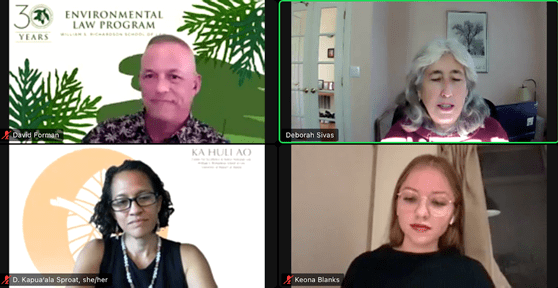Environmental justice scholars encouraged law students to examine the intersection of COVID-19, racial justice and environmental justice in the U.S. during Stanford Women in Law’s (SWIL) Environmental Justice Panel on Monday.
Speakers from California and Hawaii with diverse experiences in environmental justice discussed the evolving nature of the field amid racial unrest and climate change in the United States. The panelists also offered advice to law students and encouraged them to learn about the fields of environmental justice and environmental law.
Kapua Sproat, a director and professor of Native Hawaiian Law at the University of Hawaii, said that her Hawaiian roots inspired her to make a difference in her homeland of Hawaii through the legal field. During the pandemic, Sproat has worked on expanding access to resources such as the environmental law clinics, Native Hawaiian law clinics and law summer programs at the University of Hawaii. Through her work, she aims to address the role of environmental justice as it relates to the evolving role of racial justice in the U.S. today.
“Environmental justice and racial justice are inextricably intertwined,” Sproat said. “I’ve had the great privilege of working on a whole range of issues in the field from endangered species to water quality to military issues. In environmental justice work, we seek to redress the legacy of colonialism and the appropriation of native fine land and resources.”
Director of Stanford Law School’s Environmental Law Clinic Deborah Sivas J.D. ’87 said that environmental justice has evolved in the wake of social upheaval and racial unrest in the U.S. after the deaths of several Black people at the hands of police.
“It has been a very difficult year for a lot of people, especially communities of color,” Sivas said. “The key is moving forward and staying engaged amidst this national crisis.”
The panelists explained the complex and long-lasting environmental, economic and cultural impact of the pandemic in both Hawaii and California, as well as nationally and globally. Sproat said that, in addition to pandemic-related struggles, natural disasters such as hurricanes have had a devastating impact on Hawaiian land this year. The impacts of climate change on their land has inspired the panelists to expand the outreach of their work to communities like these who have been hit hard in many ways this year.
David Forman, director of the environmental law program at the University of Hawaii, urged students to get involved and stay engaged in their communities by representing marginalized groups and indigenous communities. There are many ways for students to explore the environmental justice field Forman said, such as researching water quality, serving as legal counsel in marginalized communities and working in environmental justice education.
“Part of the ways you can center indigenous communities in this field is by researching the communities,” Forman said. “You need to understand the different dynamics that are involved, and you can’t be afraid of the complexities of these issues.”
Lauren Schlick ’22, one of the panel moderators, said that SWIL aimed to educate and inspire law students to combat evolving challenges such as climate change, racial unrest and natural disasters by learning from prominent professors in the field.
The panelists recommended resources for legal students who want to expand their knowledge in the field, including legal clinics and workshops. Sproat runs clinics through the University of Hawaii and Sivas runs a clinic at Stanford.
Contact Katrina Machetta at katrinam ‘at’ missstem.org.
